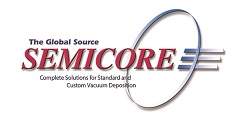Sputtering is a well-known physical vapor deposition (PVD) method finding use in several product applications. While commercial sputter systems are designed for large scale production volume of proven processes, smaller scale sputtering systems are required for research and development purposes where flexibility is typically more significant than volume throughput.
Moreover, smaller sputtering systems can also be used for lower volume initial production. This article covers the features and capabilities of smaller sputter systems designed for low volume work like research and development, especially the use of a confocal configuration of multiple targets around the perimeter of a circular rotating substrate stage.
Smaller laboratory footprint and lower cost are the key advantages of smaller chamber size. Furthermore, small circular cathodes require lesser investment for target materials. Commercially available smaller circular cathodes usually have a clamp on targets, thus making swift and easy changing of target materials. This, in turn, makes it feasible to own and use targets of many different materials to facilitate development work on many fronts.
Configuration of Smaller Sputter Systems
Such a smaller sputter system can be easily configured in any desired orientation, for sputter horizontally, sputter up, or sputter down. This complete tri-axis capability is capable of utilizing any desired pumping configuration such as turbo or cryo. Moreover, a simple single chamber can be used either as fully vented for loading and unloading or with a manual or mechanized transfer arm load lock.
One key configuration aspect for optimum versatility is a rotating substrate stage centered inside a ring of cathodes, which are angled in towards it in a confocal configuration. This configuration offers each cathode the ability to deliver adequate deposition coverage throughout the entire stage surface when it rotates, providing acceptable uniformity on the substrate(s). Using sufficient power supplies and controls, it is possible to fire these cathodes either individually or two (or more) at once for co-deposition.
It is possible to use any number and desired types of cathode power supplies, such as pulsed DC, RF or DC. These power supplies are cheaper because they will be smaller than those used in large high volume equipment. Moreover, the lower power cathodes decrease the demand for such facility support as total cooling water required or electrical power required.
Multiple gas channels can be included in gas systems, as would be desired for reactive sputtering, and either upstream or downstream pressure control can be added as desired.
Another aspect that can extend the versatility for experimentation and process development is the substrate stage temperature capability, which is typically a stage heater; however, it is also possible to have some amount of cooling, while a bit more involved. It is also possible to perform optional things such as substrate bias and features such as ion beam or sputter etch.
It is possible to fix cathodes’ count, position and orientation at a lower cost or to have some degree of mechanical adjustment capability such as distance or angle. Apparently, the addition of multiple cathodes will result in a somewhat larger chamber, and the addition of each cathode or power supply or other aforementioned features involves some cost elements.
Nevertheless, if it is necessary to have these features, then they need to be included whether in a larger system or in a smaller platform. On the whole, any feature that could be included to a large system could be added to a small one.
Conclusion
The cost involved in the addition of features to smaller sputtering systems will definitely be lesser than that for a larger, higher throughput system. Hence, the smaller chamber, confocal cathode array method remains a feasible method to have all the required features at a lower cost when compared to other methods to configuring a sputtering system for development work either in a university laboratory or in a commercial facility.
About Semicore Equipment
Semicore is a manufacturer and worldwide supplier for the electronics, optical, solar energy, medical, automotive, military and related high technology industries.
Our high-performance production or R&D vacuum sputtering and thin film evaporation systems provide coatings on a variety of materials including plastic films, glass, ceramics, metals and hybrid substrates.
Whether you want to take advantage of our proven industrial solutions for vacuum system automation, process control and supervisory monitoring applications or need to develop some unique new application of your own design you will find Semicore’s staff and facilities to be competent, open-minded and eager to help.

This information has been sourced, reviewed and adapted from materials provided by Semicore Equipment.
For more information on this source, please visit Semicore Equipment.